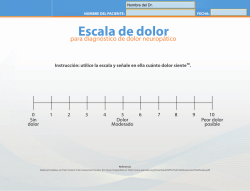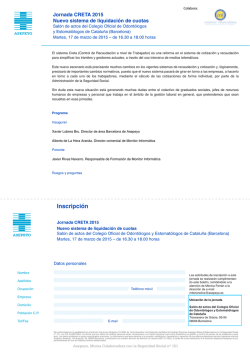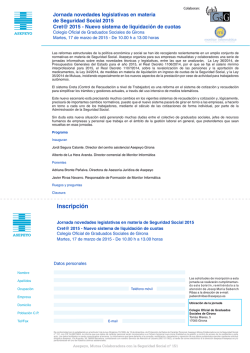
Mirror Therapy
http://www.bbc.co.uk/news/magazine-15938103 Asepeyo MATEPSS nº 151 http://www.phisios.com/2014/04/uso-de-la-terapia-espejo-en-pacientes.html Mirror Therapy INTRODUCCION G.Rizzolatti década de los 90 V.Ramachandran (1996) - Interés en la sinestesia - Efectos en “phantom limb pain” - Década de los 90 McCabe y Moseley (2004 en SDRC I : Graded Motor Imagery ) neuronas en espejo http://www.b-zion.org.il/pages/1111.aspx Asepeyo MATEPSS nº 151 http://m1.paperblog.com/i/12/125919/neuronas-espejo-red-que-une-L-1.jpeg Feedback Sensorial DESEQUILIBRIO Señales motoras REORGANIZACIÓN CORTICAL NORMALIZAR EL MOVIMIENTO PARA “CORREGIR” SU REPRESENTACIÓN EN EL H. DE PENFIELD Asepeyo MATEPSS nº 151 Mirror Therapy RECONSTRUCCIÓN DE LA LATERALIDAD ACTIVACIÓN DEL CORTEX PREMOTOR PIMG IMAGINACIÓN MOTORA MOVIMIENTO ACTIVO CON FEEDBACK VISUAL CON EL ESPEJO ACTIVACIÓN DEL CORTEX MOTOR ACTIVACIÓN DE LAS NEURONAS ESPEJO Asepeyo MATEPSS nº 151 Mirror Therapy INDICACIONES Tratamiento del dolor neuropático del miembro fantasma en amputados.(1) Síndrome de dolor regional complejo ( SDRC ).(2) Hemiparesia por lesiones cerebrales, ictus, etc.(3) Negligencias hemiespaciales.(3) 1-Chan, B. L., Witt, R., Charrow, A. P., Magee, A., Howard, R., Pasquina, P. F., ... & Tsao, J. W. (2007). Mirror therapy for phantom limb pain. New England Journal of Medicine, 357(21), 2206-2207. 2- Moseley, G. L. (2004). Graded motor imagery is effective for long-standing complex regional pain syndrome: a randomised controlled trial. Pain, 108(1), 192-198. 3-Altschuler, E. L., Wisdom, S. B., Stone, L., Foster, C., Galasko, D., Llewellyn, D. M. E., & Ramachandran, V. S. (1999). Rehabilitation of hemiparesis after stroke with a mirror. The Lancet, 353(9169), 2035-2036. Asepeyo MATEPSS nº 151 Mirror Therapy METODO 15-60 minutos 1-2 veces al día 4-8 semanas Complemento al tto convencional mirror box therapy prismglasses Protocolo McCabe 10' : 4-5 V/día observa imagen 2' visualización mental de movimiento mov.ambas ext Respetar: • No dolor • Trabajo domiciliario McCabe, C. S., Haigh, R. C., Ring, E. F. J., Halligan, P. W., Wall, P. D., & Blake, D. R. (2003). A controlled pilot study of the utility of mirror visual feedback in the treatment of complex regional pain syndrome (type 1). Rheumatology, 42(1), 97-101. Asepeyo MATEPSS nº 151 Mirror Therapy RESULTADOS • Disminución del dolor neuropático (medido en escala EVA ).(4,5,6) • Aumento de la sensación de control y facilitación de la recuperación de habilidades motoras.(4,5) • Mejora del déficit perceptivo. 4- Garrison, K. A., Winstein, C. J., & Aziz-Zadeh, L. (2010). The mirror neuron system: a neural substrate for methods in stroke rehabilitation. Neurorehabilitation and neural repair, 24(5), 404-412. 5-Buccino, G., Solodkin, A., & Small, S. L. (2006). Functions of the mirror neuron system: implications for neurorehabilitation. Cognitive and behavioral neurology, 19(1), 55-63. 6- Ramachandran, V. S., & Hirstein, W. (1998). The perception of phantom limbs. The DO Hebb lecture. Brain, 121(9), 1603-1630. Asepeyo MATEPSS nº 151 Mirror Therapy ¿ QUE NOS DICE LA FBE ? http://articulo.mercadolibre.com.mx/MLM-475976013-libro-medicinabasada-en-evidencias-principios-basicos-y-_JM#redirectedFromParent http://medicinainterna.com.co/unal/mbe/mbe.html Asepeyo MATEPSS nº 151 ¿ QUE NOS DICE LA FBE ? Mirror Therapy García Carrasco, D., and J. Aboitiz Cantalapiedra. "Efectividad de la imaginería o práctica mental en la recuperación funcional tras el ictus: revisión sistemática." Neurología (2013). 23 ECA con hemiparesia Efectiva combinado con terapia convencional Heterogeneidad en cuanto a las técnicas de evocación mental, volumen de entrenamiento…. Se necesitan más estudios para determinar el protocolo ideal Morales-Osorio, M. A., and J. M. Mejía-Mejía. "Tratamiento con imaginería motora graduada en el síndrome de miembro fantasma con dolor: una revisión sistemática." Rehabilitación 46.4 (2012): 310-316. Resultados : la IMG reduce el dolor y la discapacidad de estos pacientes sobretodo con dolor crónico Se necesitan ECA con mayor muestra ,etc Asepeyo MATEPSS nº 151 Mirror Therapy CONCLUSIONES La terapia en espejo es una herramienta terapéutica de fácil aplicación, bajo coste y sin efectos secundarios adversos que con el entreno en un centro y el posterior trabajo en el domicilio puede ayudar a través de la retroalimentación visual a mejorar déficits perceptivos y de movilidad. Asepeyo MATEPSS nº 151 Asepeyo MATEPSS nº 151 WEB www.noigroup.com www.Bodyinmind.org VIDEOS Understanding Pain: What to do about it in less then five minutes. http://www.youtube.com/watch?v=4b8oB757DKc Lorimer Moseley: Why Things Hurt - http://www.youtube.com/watch?v=gwd-wLdIHjs Referencias • • • • • Butler D, Moseley L. Explain Pain. 2003. NOI group. Adelaide, Australia. Institute of Medicine Report from the Committee on Advancing Pain Research, Care, and Education: Relieving Pain in America, A Blueprint for Transforming Prevention, Care, Education and Research. The National Academies Press, 2011. http://books.nap.edu/openbook.php?record_id=13172&page=1. AAPM Facts and Figures on Pain. The American Academy of Pain Medicine. http://www.painmed.org/PatientCenter/Facts_on_Pain.aspx#refer. Delitto A, et al. Low Back Pain: Clinical Guidelines. JOSPT. 2012; 42(4): A1-A47. Bowering J, et al(2013) The Effects of Graded Motor Imagery and Its Components on Chronic Pain: A Systematic Review and Meta-Analysis. J. of Pain 14(1):3-13. Asepeyo MATEPSS nº 151 Bibliografia Diversa • Rizzolatti G, Sinigaglia C. Las neuronas espejo: los mecanismos de la empatía emocional, Paidós, 2006. • Rizzolatti G., Craighero L., “The mirror neuron system”, Annual Rev. Neuroscience 27, 2004 • Gangitano M., Mottaghy F.M , Pascual-Leone A., “Phase specific modulation of cortical motor output during movement observation”, Neuro Report 12, 2001. • Ramachandran VS, Hirstein W. The perception of phantom limbs. The DO Hebb lecture. Brain 1998;121(9):16031630. • Garrison KA, Winstein CJ, Aziz-Zadeh L. The mirror neuron system: a neural substrate for methods in stroke rehabilitation. Neurorehabil Neural Repair 2010;24(5):404-412. • Buccino G, Solodkin A, Small SL. Functions of the mirror neuron system: implications for neurorehabilitation. Cognitive and behavioral neurology 2006;19(1):55-63. • Moseley GL, Gallace A, Spence C. Is mirror therapy all it is cracked up to be? Current evidence and future directions. Pain 2008;138(1):7-10 Asepeyo MATEPSS nº 151
© Copyright 2026


